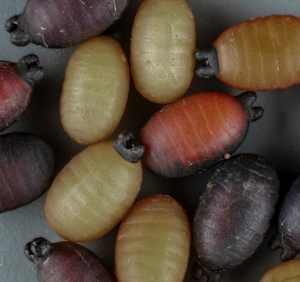
Tsetse (Glossina sp.), the vectors of human and animal African trypanosomiasis, are one of nature’s little oddities. Most insect mothers lay eggs, which are then abandoned to develop without parental care. This increases their risk of predation by larger insects, vertebrates, and vector biologists doing larval collections. Meanwhile, a tsetse mother matures one larva at a time in her uterus, nourishing it with a substance akin to a vanilla milkshake. When the larva reaches full maturity, the mother births it in a process known as larviposition. When the larva contacts the soil, it burrows below the surface to pupate in this dark, protected and temperature-buffered environment.
But an intriguing question remains – how does the mother choose where to deposit her larva, having invested so much of her energy producing it? It seems unlikely that this super-mum would randomly let her offspring burrow into any old dirt. Although earlier studies suggested the mother is lured to birthing sites by pheromones emitted by previously pupated larvae, new research conducted by scientists from the Francis Crick Institute and the Liverpool School of Tropical Medicine (LSTM) now shed more light on this hypothesis.

Naturalistic and stress-free behavioural paradigm for studying tsetse larviposition
The Glossina morsitans morsitans (Savanna tsetse) colony at LSTM has been a valuable resource for researchers since 2004. However, despite this domestication, tsetse remain the prima donnas of insect rearing. Even small changes in their environment, such as an insectary visit by someone wearing Lynx body spray, can cause the mothers to spontaneously abort their larvae. Given how sensitive these flies are to their surroundings, it was crucial to minimize stress in a set of experiments focused on larviposition. Using the large established colony, the team compared the weight of pupae produced in the colony to those obtained from the mothers used in the behavioural assays. They found that pupal weights were well within the colony’s normal distribution, confirming that the experimental protocol neither caused significant stress to the females, nor did it compromise energy investments in offspring.
To create a more natural environment for larviposition, the researchers gave pregnant females a choice between trays containing 1) sterilized sand or 2) leaf litter. After 48 hours, they counted the number of pupae in each tray and found that tsetse overwhelmingly (91%) preferred to deposit larvae into the leaf litter. This result highlights using sand alone as a larviposition substrate is suboptimal.
n-Pentadecane does not attract pregnant tsetse in naturalistic settings
Previous tsetse studies identified n-pentadecane as a pheromone that attracted G. m. morsitans females to larviposition sites. To investigate this further, Adden and Haines created a naturalistic experimental setup using stimulus trays now covered with sterile leaf litter. One tray contained filter paper treated with n-pentadecane, while the other served as a control using paraffin oil. The experiment was repeated 12 times using a total of 601 heavily-pregnant female tsetse. Surprisingly, the presence of n-pentadecane did not influence the females’ choice of larviposition site. In fact, pregnant female flies split their preference equally between the n-pentadecane tray and the control (50:50).

Pregnant tsetse ignore odours released by live pupae
Are there any larval or pupal odours that attract pregnant tsetse, if not n-pentadecane? To investigate this, 20 larvae were added to a tray filled with sand. These larvae pupated within 5 minutes and remained in the sand, which was then covered in leaf litter. Pregnant females were given the choice between this natural pupae stimulus vs. a tray of sand free of pupae. As with the n-pentadecane experiment, there was no preference for either tray.
Final thoughts
This study offers valuable new insights into the lifestyle of tsetse – flies that are not only fascinating in their maternal care behaviour, but also long-standing adversaries due to their exclusive blood-feeding and potential transmission of the trypanosome parasites causing African trypanosomiasis. Successful vector control measures have reduced the burden of human African sleeping sickness, but the disease remains a challenge, particularly in livestock. Although using larviposition pheromones for vector control was an intriguing idea, this study, along with field analyses and modelling by Hargrove and colleagues, suggests it is unlikely to work.
This study highlights how incorporating more naturalistic conditions, like leaf litter, improves experiments with tsetse mothers to obtain data that better aligns with field observations. Overall, the most important takeaway from this research is the need to constantly revisit and value older publications – never take anything for granted. This work provides a prime example of how re-examining established ideas can lead to new discoveries and insights. As researchers continue to tackle the challenges posed by tsetse and other disease vectors, this approach will undoubtedly prove invaluable.

Comments